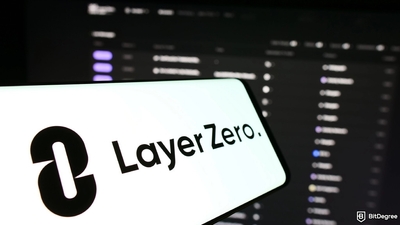Key Takeaways
- Bitstamp offers multiple withdrawal options, including SEPA, ACH, wire transfers, and crypto withdrawals, allowing users flexibility based on location and needs;
- Bitstamp withdrawal fees are generally competitive but may vary compared to other exchanges like Binance, Kraken, and Coinbase, depending on the method chosen;
- Planning around factors like Bitstamp withdrawal limits, network congestion, and account verification can help ensure a smooth transaction every time.
Free Airdrop Season 7 is LIVE! Answer fun questions or do simple tasks to earn rewards from the $30K BitDegree prize pool. Participate Now ! 🔥
If you’re familiar with exchanges like Binance, Kraken, and Coinbase, you know that each one has its unique process for managing withdrawals. When it comes to withdrawal, Bitstamp offers a reliable and simple experience. However, the process can be a bit confusing, especially for those new to using cryptocurrency exchanges.
In this guide, I’ll break down each step you need to complete a successful Bitstamp withdrawal. Whether you’re looking to move funds back to your bank or another wallet, this walkthrough will help make your Bitstamp cash out as seamless as possible.
Expect to learn about the associated fees, processing times, and some essential tips to keep your funds secure and get them where they need to go without any unnecessary delays. Ready to cash out on Bitstamp? Let’s dive in.

Did you know?
Subscribe - We publish new crypto explainer videos every week!
Non-custodial Wallet: Why Do You Need It Right NOW


Table of Contents
- 1. Understanding Bitstamp Withdrawals
- 1.1. Is Bitstamp Withdrawal Secure?
- 2. Getting Started: Setting Up for Your First Withdrawal
- 3. How to Withdraw Fiat on Bitstamp
- 3.1. Fiat Withdrawal Fees
- 4. How to Withdraw Cryptocurrency on Bitstamp
- 5. Comparing Bitstamp Withdrawal to Other Exchanges
- 5.1. Bitstamp VS Binance
- 5.2. Bitstamp VS Kraken
- 5.3. Bitstamp VS Coinbase
- 6. Bitstamp Withdrawal Tips for Smooth Transactions
- 7. Conclusions
Understanding Bitstamp Withdrawals
A Bitstamp withdrawal simply means moving funds from your Bitstamp account to an external destination, like your bank or crypto wallet. Whether you're taking profits, covering expenses, or shifting assets, Bitstamp offers options for both crypto and fiat withdrawals. Each has its own process and guidelines, and knowing the basics can make a huge difference in ensuring your funds go where they need to.
Latest Deal Active Right Now:Head to BitDegree Missions, gather as many Bits as possible & claim your stake of the $30,000 Prize Pool! Don't waste your time & start collecting Bits by completing Missions and referring friends.
Let’s start with the differences between crypto and fiat withdrawals. A Bitstamp fiat withdrawal allows you to cash out crypto assets to your bank account. If you’re withdrawing EUR, for example, you’ll typically use SEPA (Single Euro Payments Area) transfers, which tend to be faster and cheaper for European users. If you’re outside Europe or using a different currency, options like international wire transfers are available, though they can take longer and may include additional fees.
On the other hand, crypto withdrawals involve moving your assets to an external wallet address you control. Bitstamp withdrawal to wallet requires you to carefully enter your wallet details, as crypto transactions are irreversible once sent. While crypto withdrawals are generally faster than fiat, the timing can depend on the network you’re using, like Bitcoin or Ethereum, and the current network congestion.
Is Bitstamp Withdrawal Secure?
As you’re considering your Bitstamp cash-out options, it’s also helpful to understand the platform’s security measures. Bitstamp has a solid reputation for reliability, and since its founding in 2011, it’s become one of the longest-standing exchanges. However, in 2015, Bitstamp did experience a major security breach, with hackers accessing and compromising its hot wallet system.
Although this was a challenging moment for the platform, Bitstamp responded by completely upgrading its security practices. Today, it prioritizes user protection with robust measures, such as cold storage for most funds, two-factor authentication (2FA), and routine security audits to prevent similar incidents.
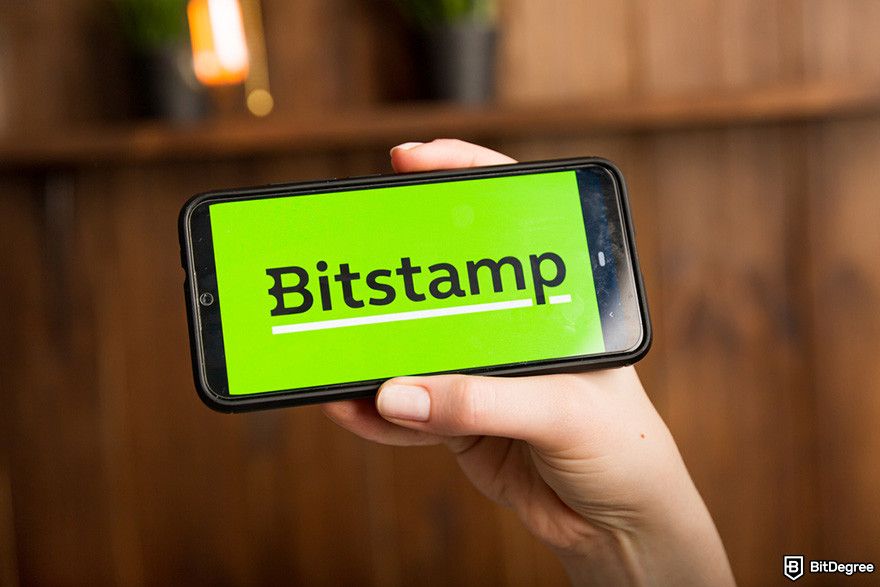
By keeping a close eye on both security and user experience, Bitstamp has positioned itself as a trustworthy exchange for users worldwide. Understanding the essentials of withdrawal, Bitstamp can help make your transactions smoother and more secure, whether you’re moving crypto to your own wallet or transferring cash to your bank.
Getting Started: Setting Up for Your First Withdrawal
There are several setup processes you need to go through before you can withdraw funds from Bitstamp to bank account or external wallet. But no need to worry! I’m here to guide you through the entire steps and ensure you can do it with ease.
Now let’s assume that you don’t have a Bitstamp account. The first step is to create a new one and complete the Know Your Customer (KYC) process. Completing the KYC process is essential for anyone using a regulated exchange like Bitstamp. KYC involves verifying your identity by submitting documents, such as a government-issued ID and proof of address.
This process is in place to prevent illegal activities like money laundering, fraud, and other financial crimes, ensuring a secure environment for all users. Without KYC, users wouldn't have access to key functions—like withdrawal. Bitstamp requires verified accounts to withdraw either fiat or crypto. So, if you’re planning a Bitstamp withdrawal to wallet or a bank account, completing KYC is a must for compliance and security.
That said, here is the step-by-step guide on how to set up your Bitstamp account and complete the verification process:
Step 1: Create a new Bitstamp account by clicking “Get Started” on the homepage.
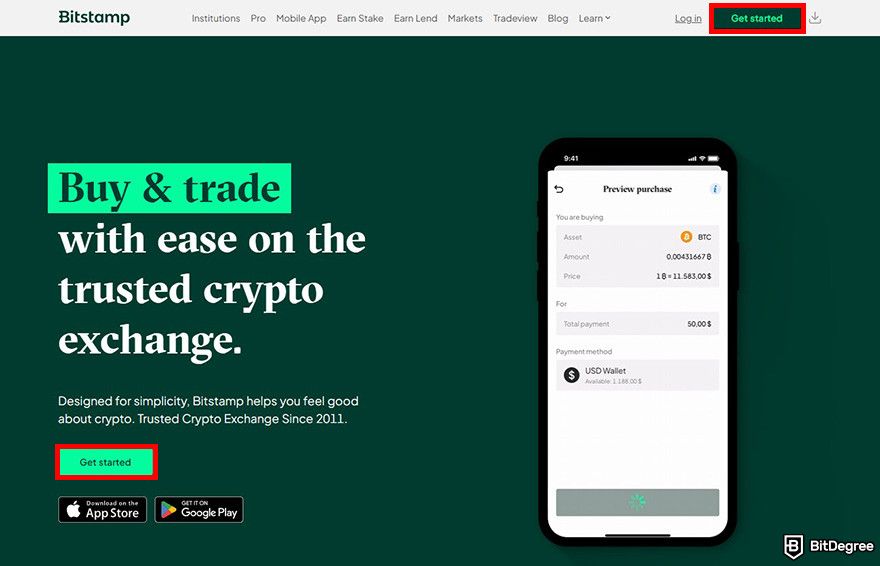
Step 2: Enter your details, including name, email, and country of residence. Once you’re done, Bitstamp will send you an email containing a link to set up your password.

Step 3: Create a strong password for your account. After that follow the account verification process.
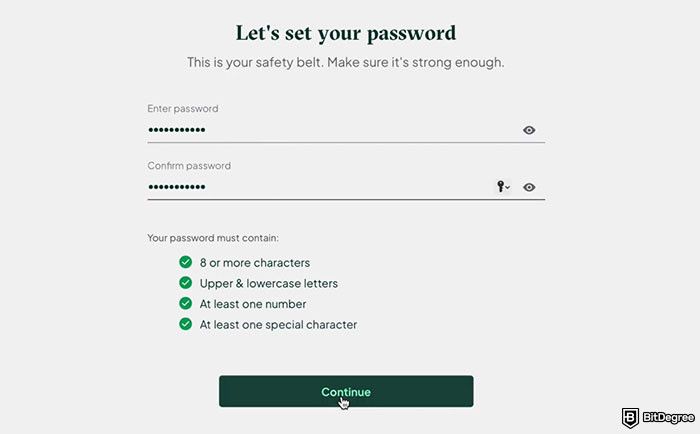
Step 4: Next, enter your residential information. Bitstamp will also ask about your country and town of birth.

Step 5: Enter your phone number and enter the verification code sent via message.

Step 6: After that, you’ll need to upload your document as part of the KYC verification process. This can be either your passport, ID card, driver’s license, or residence permit.
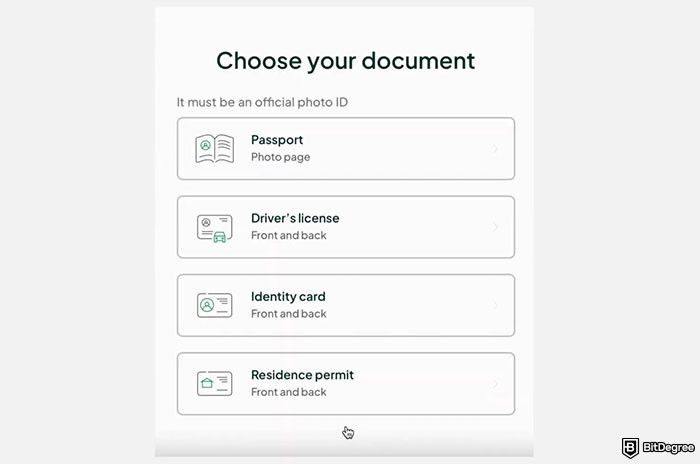
Step 7: Complete the face verification process by recording your face according to the instructions. Please note that you’ll have to use your smartphone for these identity verification processes.
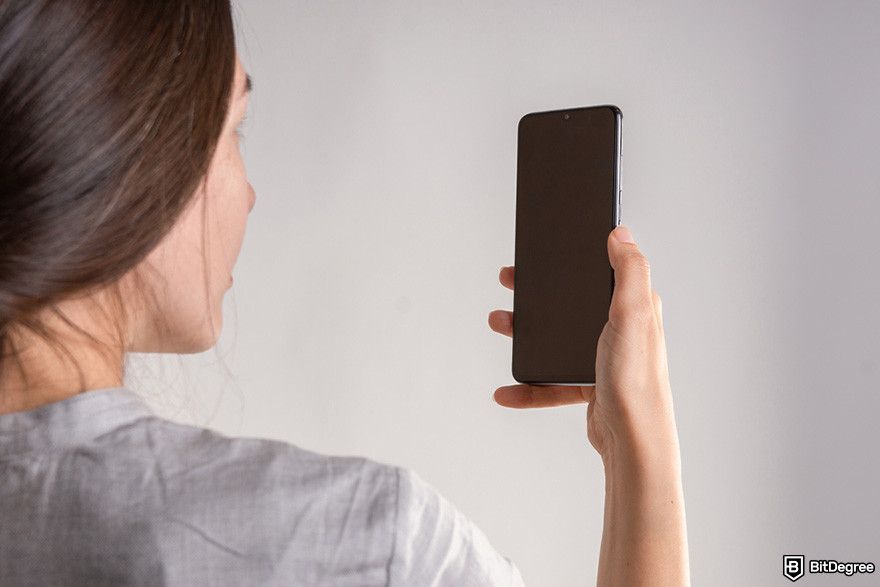
Step 8: Enter your basic financial information, such as your rough annual income and net worth. Additionally, provide information about your occupation, annual deposit estimation, and tax residency.

Step 9: Select your purpose for using Bitstamp based on available checkboxes.

Step 10: Last but not least, secure your account using the 2FA feature. You can use the Google Authenticator app on your phone or any other 2FA application.

That’s it! The verification process will normally take around 5-15 minutes. Once your account is verified, you can start using your Bitstamp account to do transactions.
How to Withdraw Fiat on Bitstamp
Before jumping into the details, it’s helpful to understand the main types of Bitstamp fiat withdrawal options available, since the method you choose can affect timing and fees. Bitstamp offers several ways to transfer your funds based on your location and currency. Here’s a quick overview:
- SEPA: Ideal for European users, this option allows EUR transfers that are generally fast and affordable.
- ACH: US users can benefit from ACH transfers, which connect directly to banks within the United States.
- International Wire: Available worldwide, wire transfers are best for large sums but may take a few days to clear.
- FPS: If you’re in the UK, Faster Payments Service (FPS) enables swift transfers in GBP.
Choosing the right option is key for a smooth withdrawal. Bitstamp also provides detailed information and guidance on their platform to help you make the best decision for your specific needs.
If you’re aiming to transfer funds from Bitstamp to bank account quickly, knowing the available methods can save time and money. Now, let’s dive into the Bitstamp fiat withdrawal steps for moving your funds securely from Bitstamp to bank account.
Step 1: Log in to your Bitstamp account and click on “Withdrawal” on the user’s dashboard.
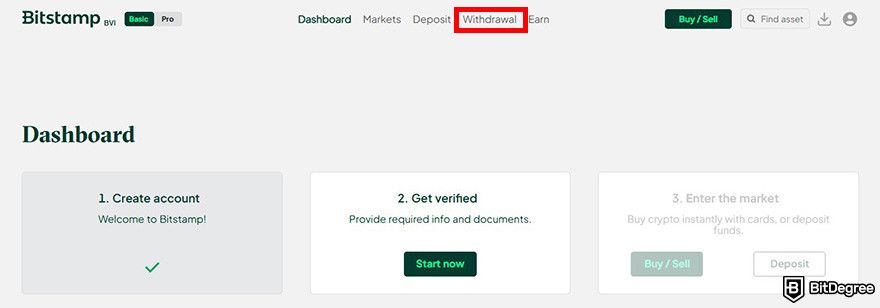
Step 2: Choose your preferred transfer method from the sidebar menu. Since you're withdrawing fiat, choose "Cash withdrawal".

Step 3: Enter all the necessary details for the transfer, including the preferred currency and amount to withdraw.
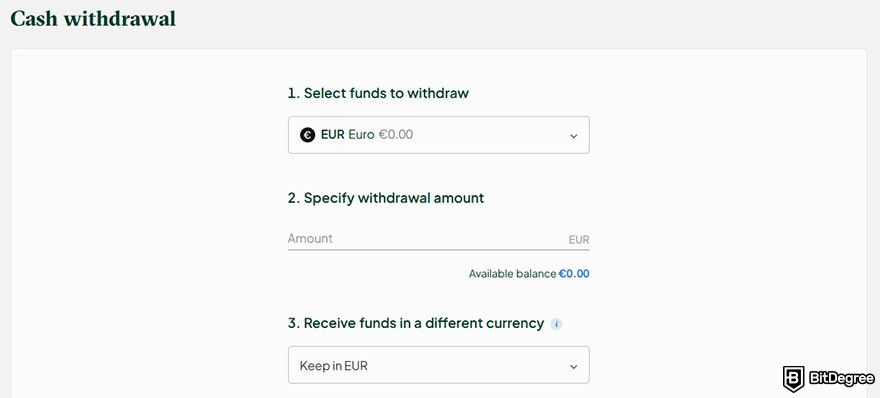
Step 4: Select your preferred withdrawal method. If you haven't registered your bank account, you can add a new one here. Once you're done, click "Continue to preview"

Step 5: On the “Withdrawal Overview” page, your most recent order will be listed with the status “E-mail confirmation needed”. Check your email inbox and confirm the transaction.
Step 6: Wait until the funds come up on your destination account. The status will change to “Finished” once the whole process is completed.
By now you might be wondering how much time is required for the platform to process your withdrawal. Bitstamp will typically send your funds within 1-2 business days for most methods except for international wire transfer which normally takes around 3-5 business days to complete.
Fiat Withdrawal Fees
Another thing you need to consider when learning about Bitstamp fiat withdrawal is the fee associated with it. Here is the fee schedule breakdown to help you understand what you may need to pay when doing a Bitstamp cash-out:
| Method | Withdrawal Fees |
| ACH (USD) | Free |
| SEPA (EUR) | €3.00 |
| International Wire | 0.1% (min fee = 25 USD/EUR/GBP) |
| FPS (GBP) | £2.00 |
As you can see, there are basically no Bitstamp withdrawal minimums for fiat except with the international wire. However, you need to know the Bitstamp withdrawal limit for some of these methods. The upper limit for Bitstamp USD withdrawal using ACH is $50,000 per transaction while FPS limits your withdrawal to £250,000 per transaction.
Keep in mind that when you withdraw from Bitstamp to bank account, your bank may charge additional fees. Furthermore, there are also bank exchange rates if you initiate a Bitstamp withdrawal that requires currency conversion.
How to Withdraw Cryptocurrency on Bitstamp
Now that you’ve learned how to withdraw funds from Bitstamp to bank accounts, it is time to explore how you can do Bitstamp withdrawal to wallet. A crypto withdrawal can be a great alternative to fiat for those looking for faster transactions or to avoid bank fees.
The supported cryptocurrencies for withdrawing from Bitstamp to wallet include BTC, ETH, USDC, XRP, and many others. To give you a better idea, here is a step-by-step guide on how to do a Bitstamp transfer to wallet:
Step 1: Log in to your Bitstamp account and go to “Withdrawal”.

Step 2: Choose “Crypto withdrawal” on the side panel menu.
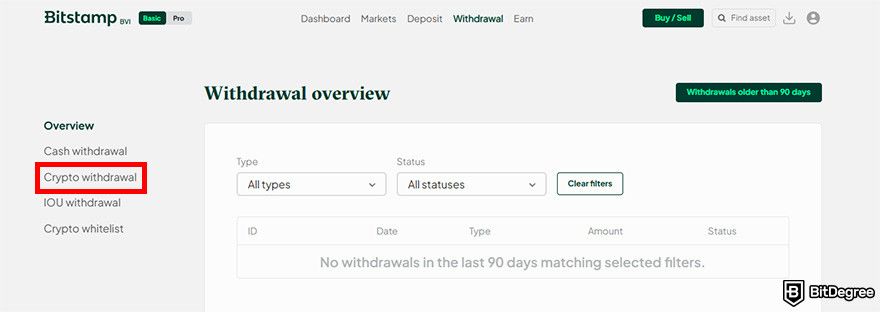
Step 3: Select your preferred asset to withdraw from the drop-down menu, for example, BTC. Click "Acknowledge and continue" after you review the fraud prevention message and questions.

Step 4: Enter the destination BTC address, label, and the amount to withdraw. After that, click "Continue".
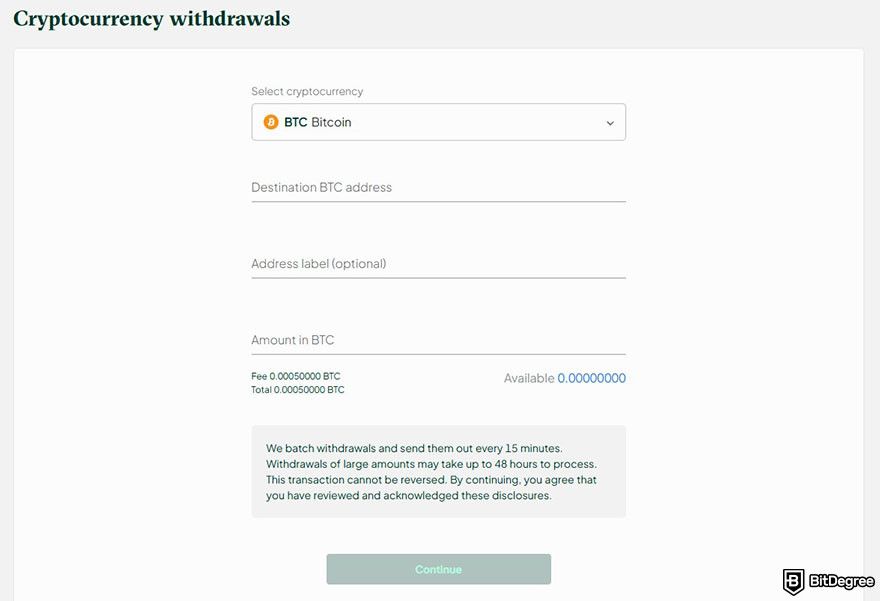
Step 6: Click “Authenticate and withdraw” and enter your 2FA code.
Step 7: Your most recent order will appear on the “Withdrawal Overview” page with the status “E-mail confirmation needed”. Check your email inbox and confirm the transaction.
Step 8: Wait until the transfer is complete and the assets turn up on the destination wallet.
The time required to complete a Bitstamp withdrawal to wallet may vary depending on factors such as network congestion. But please note that Bitstamp batches withdrawals and sends them out every 15 minutes. Additionally, withdrawals of large amounts may take up to 48 hours to process. Network congestion can slow the transfer time as high demand increases the processing load often leading to potential delays in transaction confirmations.
The fees associated with withdrawing cryptocurrencies from Bitstamp to wallet are also different for each type of asset. Bitstamp charges you a variable crypto withdrawal fee which consists of Bitstamp's estimate of the network transaction fees within a certain period and the crypto withdrawal processing fee. The exact crypto withdrawal fee is disclosed before you confirm the cryptocurrency withdrawal, so make sure to check it before you proceed with the transaction.
Comparing Bitstamp Withdrawal to Other Exchanges
When it comes to withdrawal, Bitstamp has a solid reputation, but how does it really stack up against other major exchanges like Binance, Kraken, and Coinbase? Each platform has its own approach to fees, processing times, and user experience, so knowing these differences can help you decide if a Bitstamp cash-out is the best option for your needs.

Let’s take a look at the side-by-side comparison of withdrawal, Bitstamp versus these popular exchanges, helping you see where the platform stands out—and where it might fall short.
Bitstamp VS Binance
Binance is one of the world’s largest cryptocurrency exchanges, known for its wide range of supported coins, advanced trading features, and competitive fees. Founded in 2017, Binance quickly rose to prominence due to its user-friendly interface and diverse offerings, from spot trading and staking to futures and more. Today, it serves millions of users globally, providing a reliable platform for both beginners and experienced traders alike.
Just like Bitstamp withdrawal, Binance offers multiple payment methods, including fiat withdrawals via bank transfers and crypto withdrawals to external wallets. Users can choose from methods like SWIFT, SEPA, and even PayPal, depending on their region. Binance also has fees for withdrawals, though they tend to be competitive within the industry.
That said, let's take a look at how they compare with Bitstamp withdrawal fees:
| Method | Binance Withdrawal Fees | Bitstamp Withdrawal Fees |
| P2P Express (USD) | Free | Not available |
| FPS (GBP) | Free | £2.00 |
| SEPA (EUR) | €1.00 | €3.00 |
| SBI (JPY) | ¥150 | Not available |
| Bank Transfer (TRY) | Free | Not available |
From the table above, we can see that Binance offers lower fiat withdrawal fees, particularly for EUR and GBP. Additionally, Binance also has more fiat withdrawal options, including TRY, BRL, JPY, and several others. This can be a game changer, especially for those who prefer fiat not available on the Bitstamp fiat withdrawal method.
Much like Bitstamp, the fees for crypto withdrawal on Binance vary depending on your asset and network of choice. For example, withdrawing BTC using the Bitcoin network will incur a 0.0001 BTC fee.

|

|
|
|---|---|---|
| Beginners | Advanced Users & Beginners | |
| Germany, United States, United Kingdom, Slovenia, Finland, + 100 more | Turkey, Argentina, Vietnam, Ukraine, + 180 more | |
| All Bitstamp Coupons | See All Coupons of Best Exchanges | |
| A well-established crypto exchange with an emphasis on security and regulation. | One of the leading crypto exchange platforms in the industry. | |
|
Visit site
Read review |
See TOP10 Brands
Read review |
Bitstamp VS Kraken
Kraken, established in 2011, is one of the longest-standing cryptocurrency exchanges, widely respected for its focus on security and regulatory compliance. Known for its transparent approach, Kraken has built a strong reputation as a safe and reliable platform for users around the world. The exchange offers a broad range of features, including spot trading, futures, staking, and margin trading, appealing to both beginners and seasoned investors.
For withdrawals, Kraken provides flexible options across both fiat and cryptocurrency. Fiat withdrawals can be made through SEPA, SWIFT, and wire transfers, depending on your location, each with its own fees and processing times.
With crypto withdrawals, Kraken allows users to move their assets securely to external wallets, showing transaction costs upfront and offering guidance on expected transfer times. Kraken’s commitment to clarity and security in the withdrawal process is part of what sets it apart, helping users confidently transfer their funds.
Now let’s compare between Kraken and Bitstamp withdrawal fees:
| Method | Kraken Withdrawal Fees | Bitstamp Withdrawal Fees |
| ACH (USD) | Free | Free |
| SEPA (EUR) | €0.90 - €1.00 | €3.00 |
| FPS (GBP) | £1.95 | £2.00 |
| Swift (Worldwide) | $13 - $35 | Not available |
Kraken can be a good option if you want to save on withdrawal fees since it offers lower rates compared to Bitstamp. Additionally, Kraken supports more fiat currencies and transfer methods.
On the other hand, the fees for crypto withdrawal on Kraken vary depending on the asset. For example, the fee to withdraw ETH is 0.00033 ETH. If you remember the Bitstamp withdrawal minimum rule, Kraken also implements the same rule. Each asset has a different minimum transfer amount.

|

|
|
|---|---|---|
| Beginners | Beginners | |
| United States, Germany, United Kingdom, France, Canada, + 190 more | Germany, United States, United Kingdom, Slovenia, Finland, + 100 more | |
| All Kraken Coupons | All Bitstamp Coupons | |
| One of the best crypto exchanges, especially in the US. | A well-established crypto exchange with an emphasis on security and regulation. | |
|
Visit site
Read review |
Visit site
Read review |

Did you know?
Subscribe - We publish new crypto explainer videos every week!
What is a MetaMask Wallet? (And How to Use it - Animated)



- Secure and reliable
- Accepts fiat currencies
- Lots of trading options
- Reputable exchange
- Accepts fiat currencies
- Offers various trading options

- Fiat currencies - accepted
- Simple to use
- Accepts only the most trustworthy cryptocurrencies
- A leading cryptocurrency exchange platform
- Best for beginner investors
- Accepts fiat currencies

- Beginner-friendly
- Secure
- Decent trading and withdrawal fees
Bitstamp VS Coinbase
Coinbase is a widely recognized cryptocurrency exchange that launched in 2012, quickly becoming popular for its accessible platform and commitment to regulatory standards. With its user-friendly interface and focus on security, Coinbase is often the first choice for new crypto investors, particularly in the United States.
The platform supports a range of crypto assets, enabling users to buy, sell, and manage their holdings with ease, while its educational resources help beginners get comfortable with crypto basics.
For those looking to withdraw funds, Coinbase offers flexible options for both fiat and crypto. U.S. users can withdraw fiat through ACH transfers, while European users have SEPA access, and international customers can use wire transfers. Each method varies in terms of speed and fees, allowing users to choose the most suitable option.
For crypto withdrawals, Coinbase supports transfers to external wallets, making it easy to manage digital assets outside the platform. Coinbase’s clear fee structure and straightforward withdrawal process give users confidence when moving funds. Here is how it compares with Bitstamp withdrawal fees:
| Method | Coinbase Withdrawal Fees | Bitstamp Withdrawal Fees |
| ACH (USD) | Free | Free |
| Wire (USD) | $25 | 0.1% (min fee = $25) |
| SEPA (EUR) | Free | €3.00 |
| Swift (GBP) | £1.00 | Not available |
Following the same trend, Coinbase also offers lower rates for GBP and EUR compared to the fees for Bitstamp fiat withdrawal. However, it doesn’t support as many transfer methods as Binance and Kraken.
As for crypto withdrawals, Coinbase also charges different rates based on different factors like the prevailing network fees for a stand-alone wallet-to-wallet send. However, the final fee that Coinbase pays may differ from the estimated fee due to factors such as batching transactions or changes in network congestion levels. You can check these fees before you finalize your transactions.

|

|
|
|---|---|---|
| Advanced Users & Beginners | Beginners | |
| United States, United Kingdom, Germany, Canada, France, + 100 more | Germany, United States, United Kingdom, Slovenia, Finland, + 100 more | |
| All Coinbase Coupons | All Bitstamp Coupons | |
| A reliable, well-known and respected cryptocurrency exchange platform. | A well-established crypto exchange with an emphasis on security and regulation. | |
|
Visit site
Read review |
Visit site
Read review |
Bitstamp Withdrawal Tips for Smooth Transactions
When it comes to making a smooth withdrawal, Bitstamp offers a reliable experience, but there are some practical tips that can help avoid common issues and make the process even easier. Whether you’re transferring funds to your bank or moving crypto to an external wallet, these steps can help ensure a seamless withdrawal, Bitstamp style.
- Check Your Account Verification Status: Before you initiate any withdrawal, make sure your account is fully verified. Bitstamp requires verified accounts for fiat and larger crypto transactions, so completing this step first can help avoid delays. Verifying your account involves providing identification documents and, in some cases, additional information to meet regulatory requirements.
- Review the Bitstamp Maximum Withdrawal Limit: Knowing your account limits is essential to avoid surprises. Bitstamp has maximum withdrawal limits based on account type and verification level. While the basic verified account has sufficient limits for most users, higher-volume traders may want to upgrade to increase these limits. Always check your Bitstamp maximum withdrawal limit before planning a large transaction, as this could impact your ability to move funds in one go.
- Double-Check Your Withdrawal Details: When withdrawing crypto, it’s critical to enter the correct wallet address. Crypto transfers are irreversible, so an incorrect address could result in a permanent loss of funds. For fiat withdrawals, make sure your bank account details are accurate to avoid rejected transactions. This small step can save time and prevent potential issues.
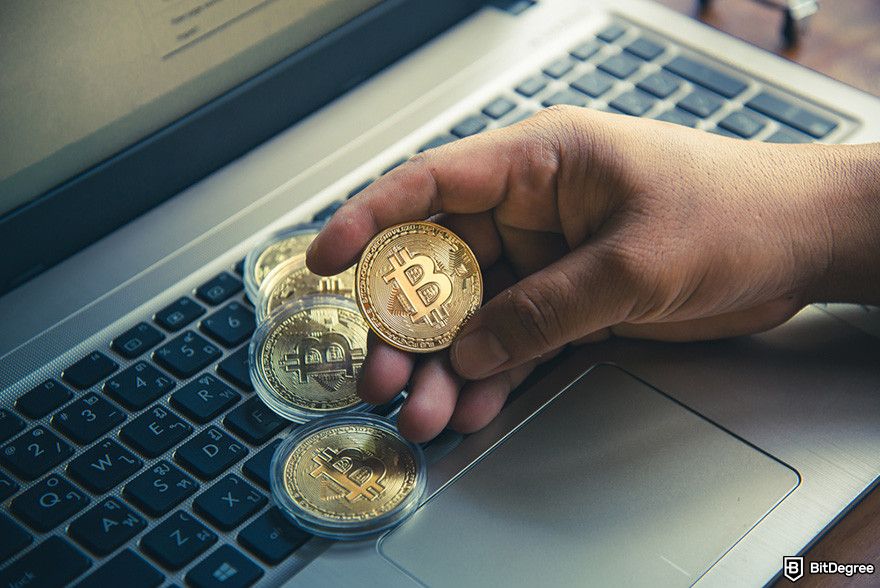
- Consider Network Congestion for Crypto Withdrawals: If you’re withdrawing crypto, be aware that Bitstamp withdrawal time can vary depending on network congestion. During high-traffic times, such as large market moves, blockchain networks may be slower, which can delay your withdrawal. Planning your withdrawal during off-peak hours may help speed up the transaction, especially for assets on popular networks like Bitcoin or Ethereum.
- Minimize Fees with the Right Timing: Timing can also impact your fees. For instance, crypto fees tend to rise when network traffic is high. By waiting until fees drop, you can potentially save on transaction costs. Additionally, choosing SEPA for euro withdrawals within Europe often results in lower fees compared to international wire transfers.
- Secure Your Account with 2FA: Bitstamp offers 2FA, which adds an extra layer of security to your account. Enabling 2FA can protect against unauthorized access, reducing the risk of any unapproved withdrawals. This is especially important if you regularly keep assets on the platform or perform frequent transactions.
By following these tips, you can help ensure your Bitstamp withdrawals are fast, secure, and cost-effective. Understanding factors like limits, timing, and fees can make a big difference, helping you navigate Bitstamp withdrawal options with confidence. Whether it’s your first time withdrawing or you’re a regular user, a bit of preparation goes a long way toward making every transaction a smooth one.
Conclusions
When it comes to withdrawal, Bitstamp stands out for its reliability, range of options, and commitment to security. Whether you’re moving funds to a bank or an external crypto wallet, understanding the Bitstamp withdrawal process makes all the difference. One thing to note is that compared to other major platforms like Binance, Kraken, and Coinbase, Bitstamp has higher fee rates for withdrawal fees.
That being said, following the steps and tips I’ve outlined can help make your Bitstamp cash out smooth and hassle-free. From choosing the right withdrawal method to securing your account with two-factor authentication, a bit of planning goes a long way.
If you’re a new user or even a seasoned trader, having a solid handle on the Bitstamp withdrawal options can help you manage your assets with confidence and ease. Here’s to successful transactions and stress-free withdrawals!
The content published on this website is not aimed to give any kind of financial, investment, trading, or any other form of advice. BitDegree.org does not endorse or suggest you to buy, sell or hold any kind of cryptocurrency. Before making financial investment decisions, do consult your financial advisor.




